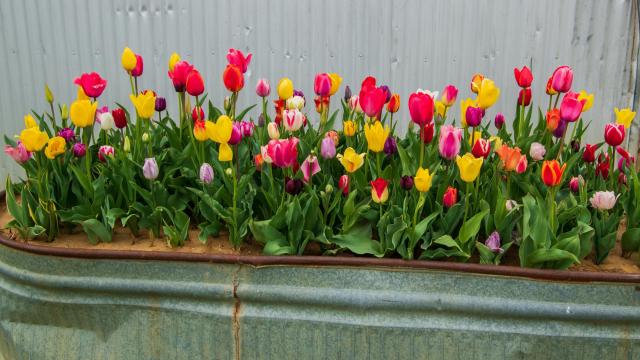Planters are fantastic: They’re mobile, easy to install anywhere, and come in different heights. If you plant bulbs in the planters, you get a great pop of color for a few weeks, exactly where you want it. But then, what about the rest of the year? How do you plant without disturbing the bulbs in the planter? The answer lies in layering your bulbs, sometimes called the “bulb lasagna” method. You get a much longer season as bulbs come and go, and with the right care, they should come back year after year.
Plant bulbs at a depth three times their size
Luckily, it’s not that hard to suss out the plan here. Bigger bulbs belong deeper in the pot, and as your progress up, you’ll continue layer in smaller and smaller bulbs. The larger bulbs need that depth to get the nutrients they need.
Choose bulbs for each season
The leading note is to choose bulbs with different bloom times. Bulbs tend to be designated late winter, early/mid/late spring, early/mid/late summer and early fall. That said, most of the bulbs really fall into late winter/late spring categories. Choosing from different designations is going to give each bulb the time and space to really fill out. I consistently return to this incredibly in-depth calendar from my local nursery—while the month-by-month timings are for the Pacific northwest, you can abide by the season designations on the left (early spring/late spring, etc). Using this chart, you could choose snowdrops, daffodils, tulips, lilies, dahlia, and amaryllis and have a full year of color, if the planter comes inside for the hardest winter months. Otherwise, it can stay outside, and might need insulation for the coldest months, or can live in your shed or garage for some protection. You can also plant into the top layer with annuals like violas in winter.
Choose the right size container for the bulbs
To ensure the layering works, you can’t overcrowd the pot, and it needs to be the appropriate depth. In that way, if you’re determined to plant specific bulbs, it’s better to choose them first, and then calculate three times the depth of the bigger bulbs, and add about five inches to that to understand the height you need for the pot.
Planter bulbs need more water and insulation
Bulbs, generally, enjoy some bulb-specific fertilizer each year, so as you plant, consider adding that to the soil mix. You should plant into a potting mix, not a soil meant for raised beds. Planters generally, by design, dry out a little faster and have less insulation than the ground, so keep that in mind. Water your bulbs after planting for a few weeks, as they are forming their roots. Insulate as per the above recommendations for winter depending on where you live. Then ensure that your bulbs have water throughout the growing season, which means the soil is always lightly moist two to three inches down—never wet or dry.

Leave a Reply
You must be logged in to post a comment.